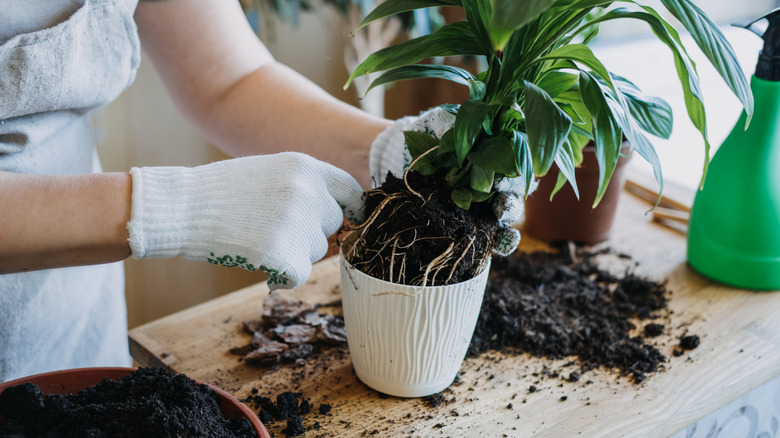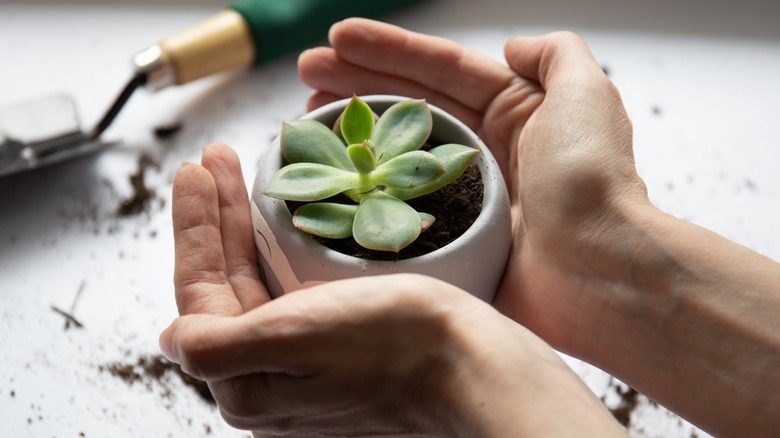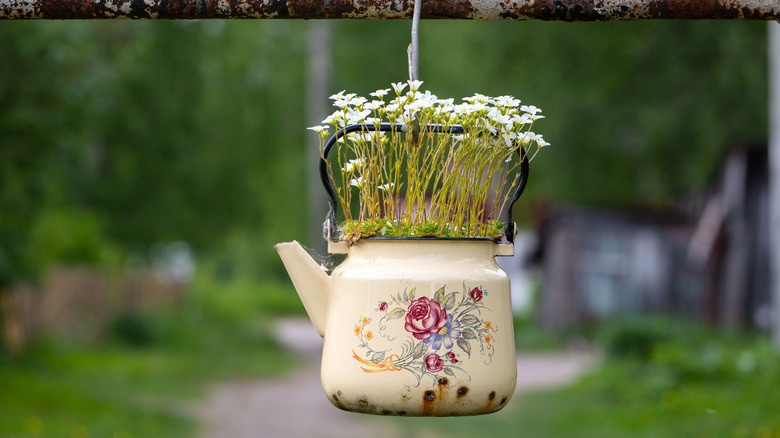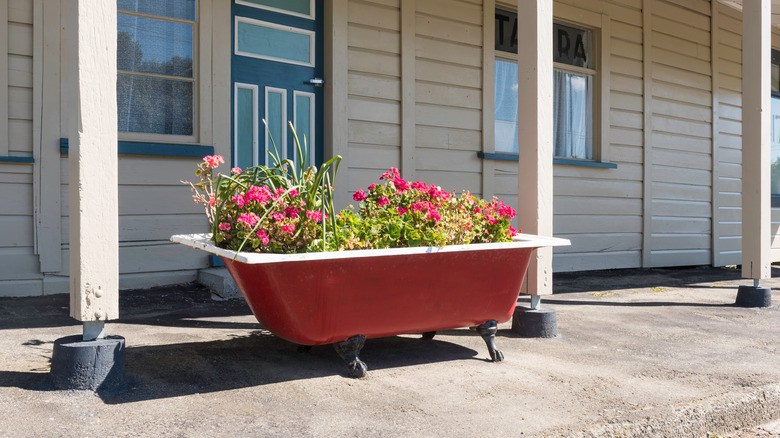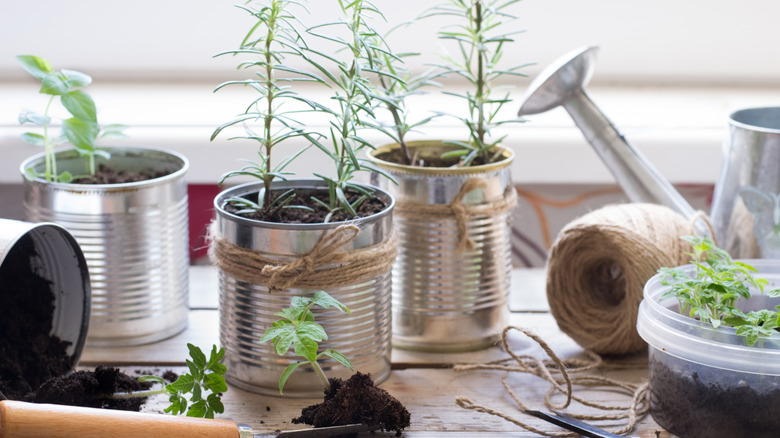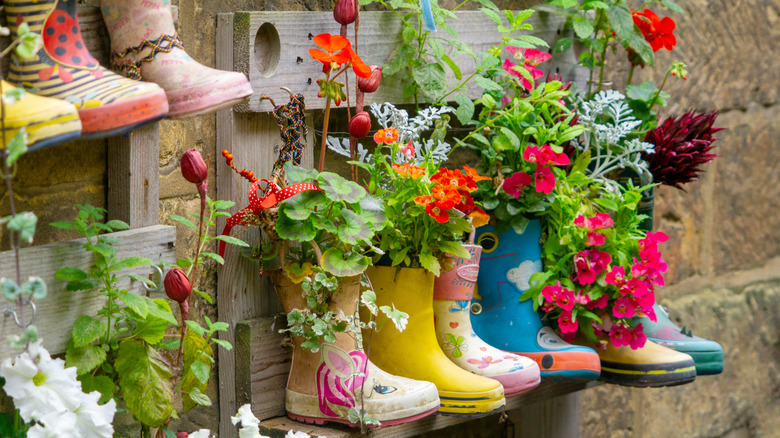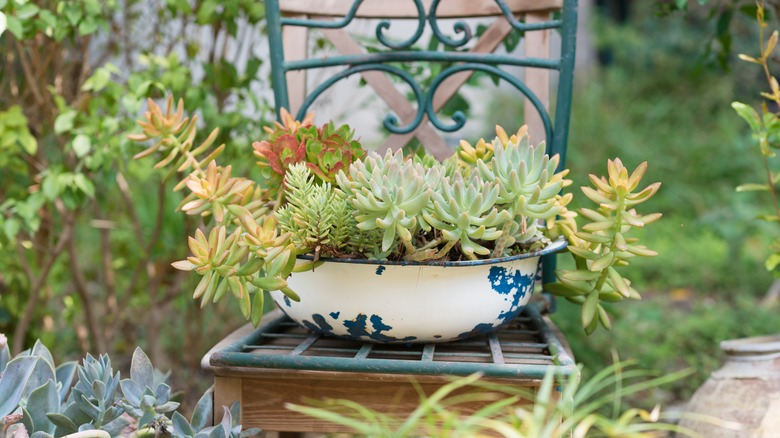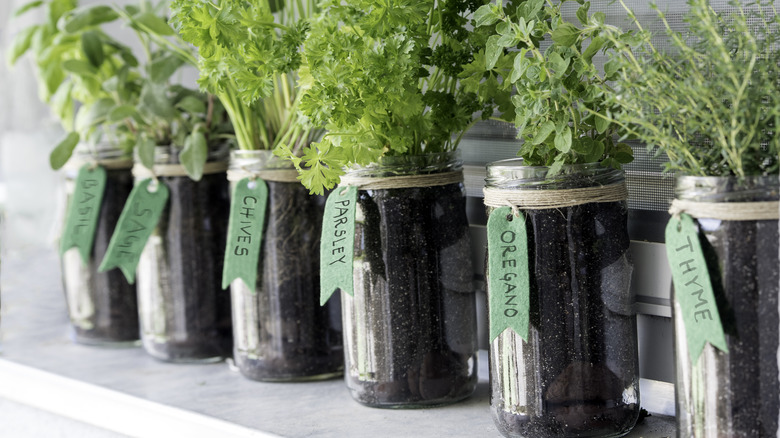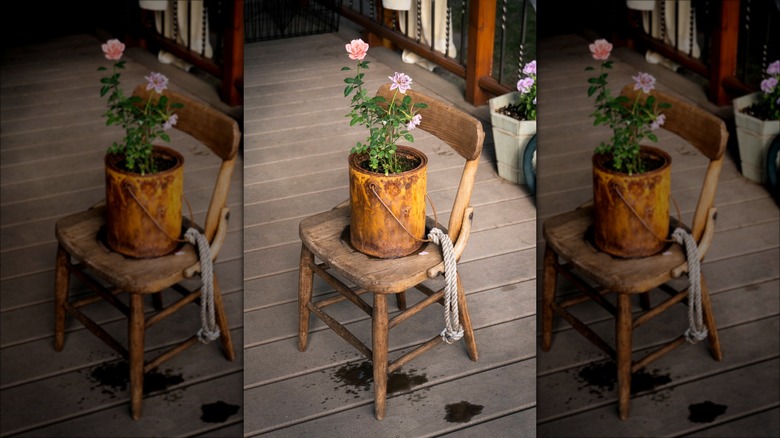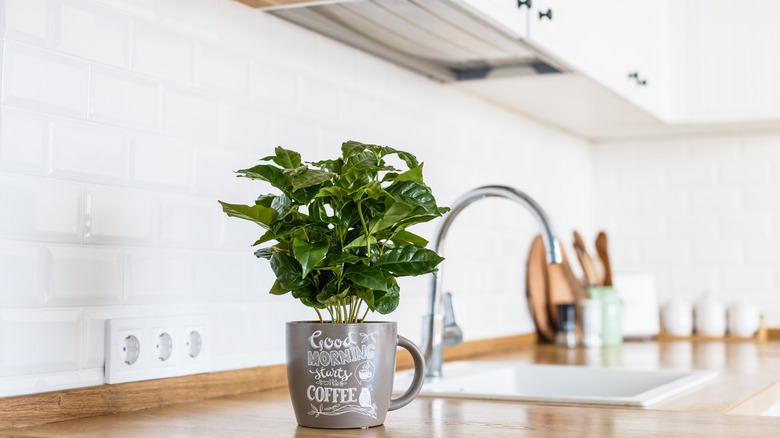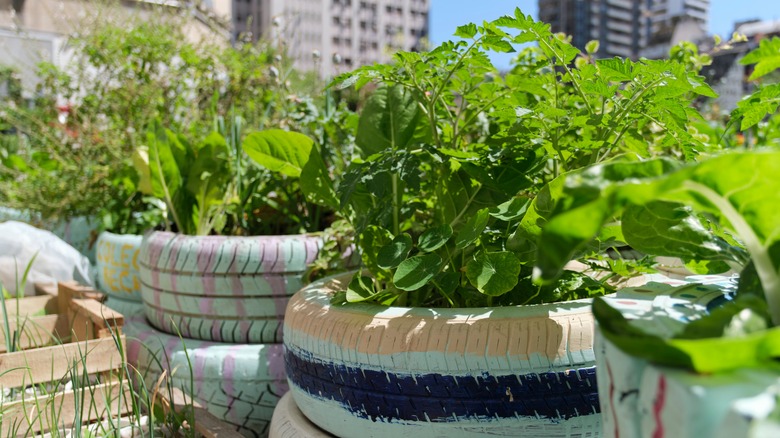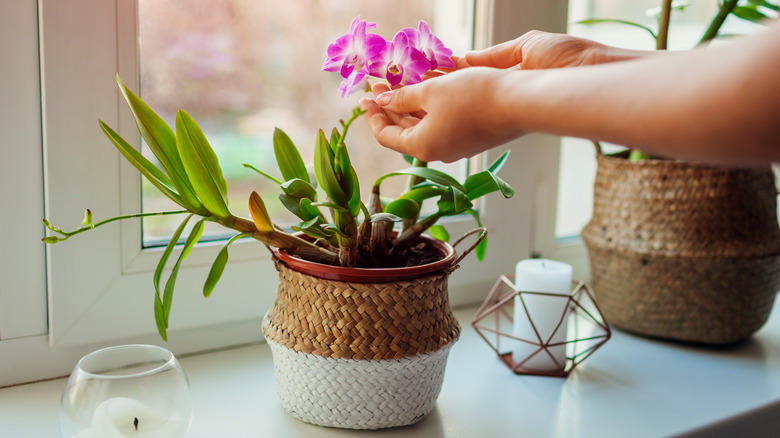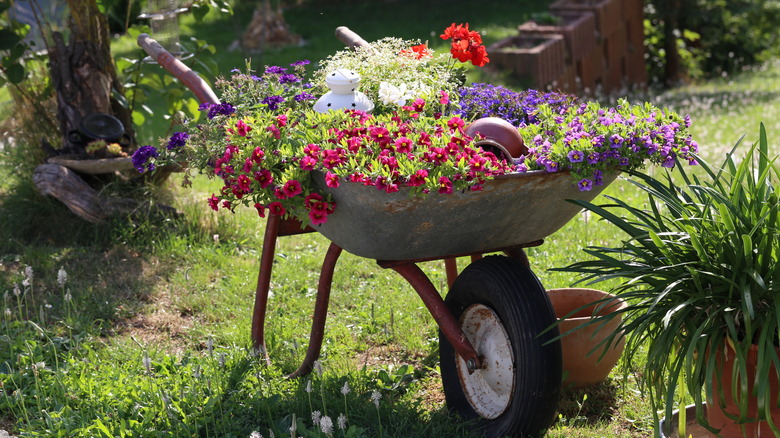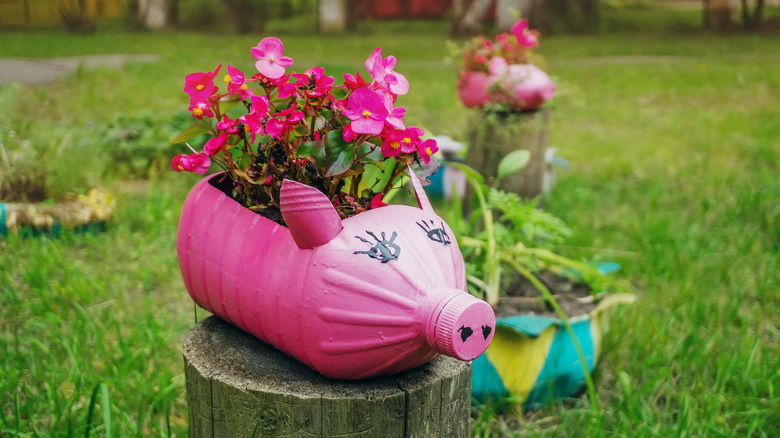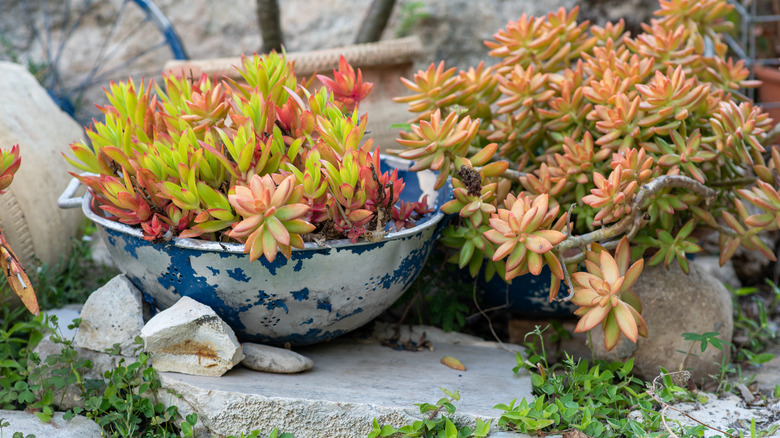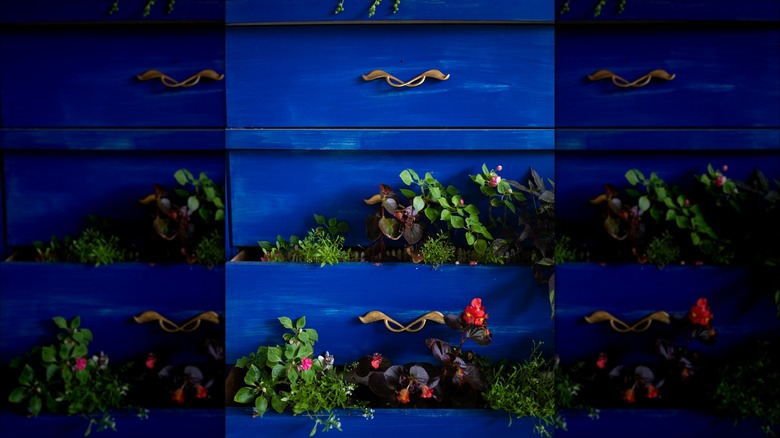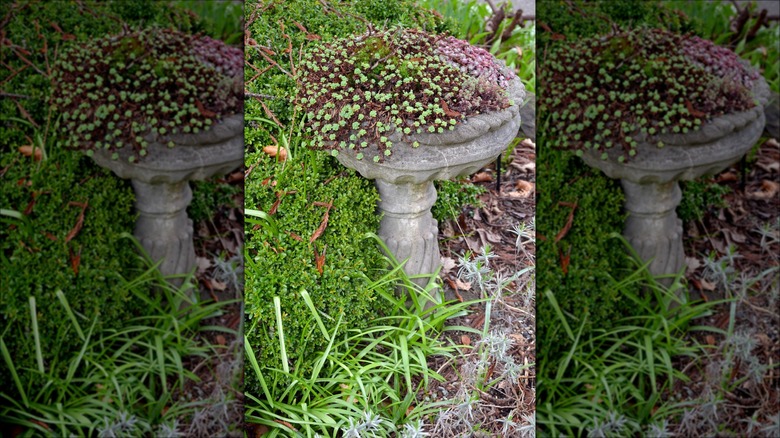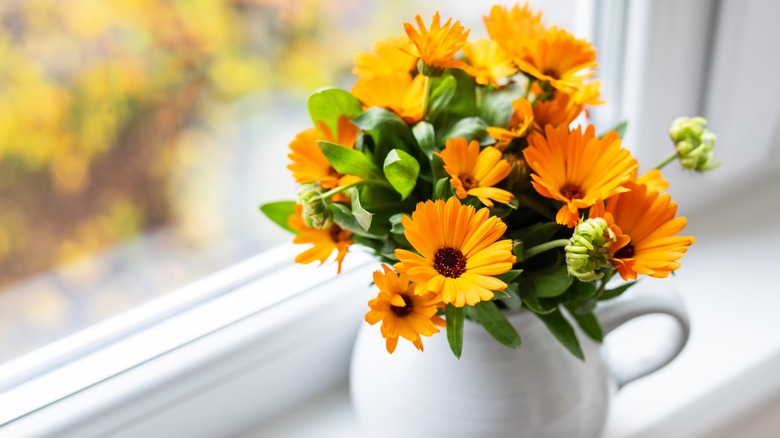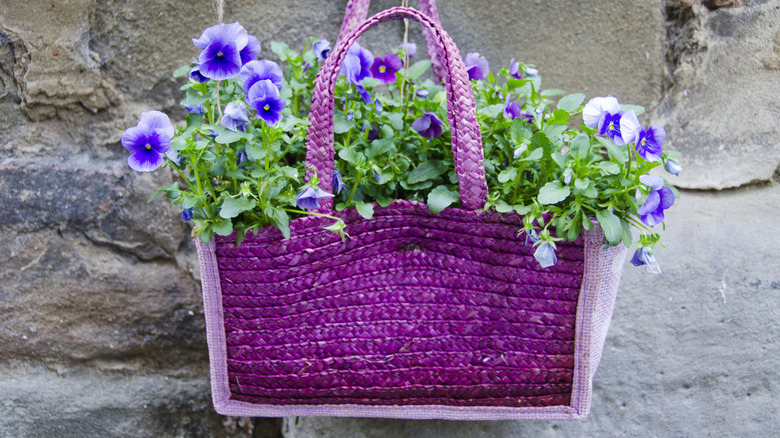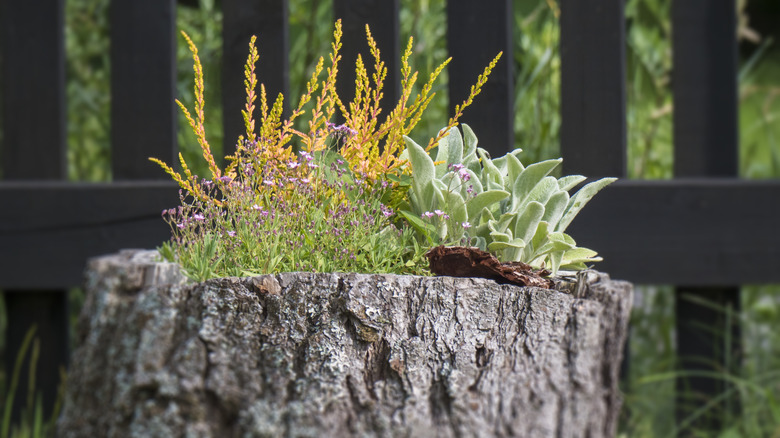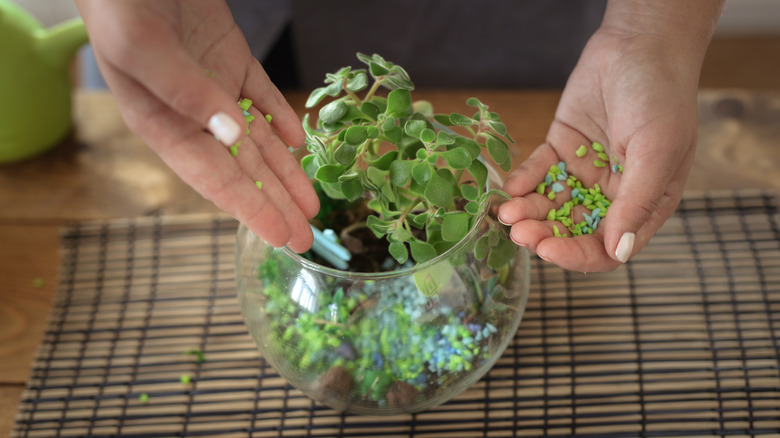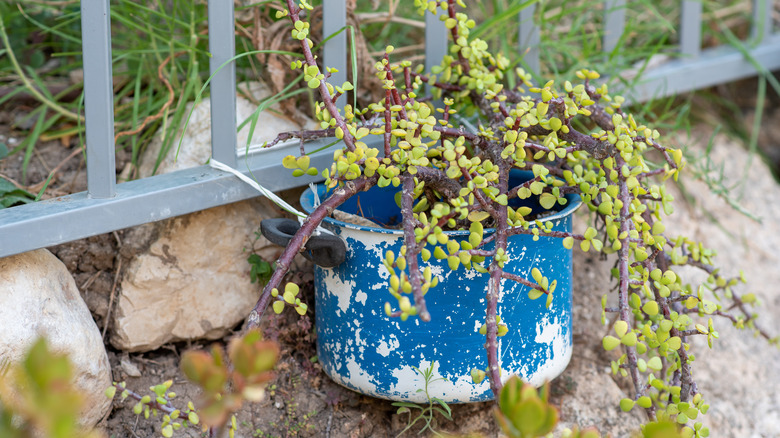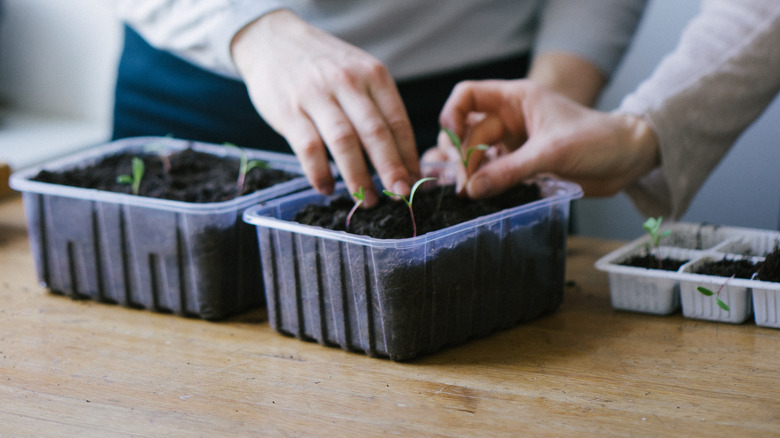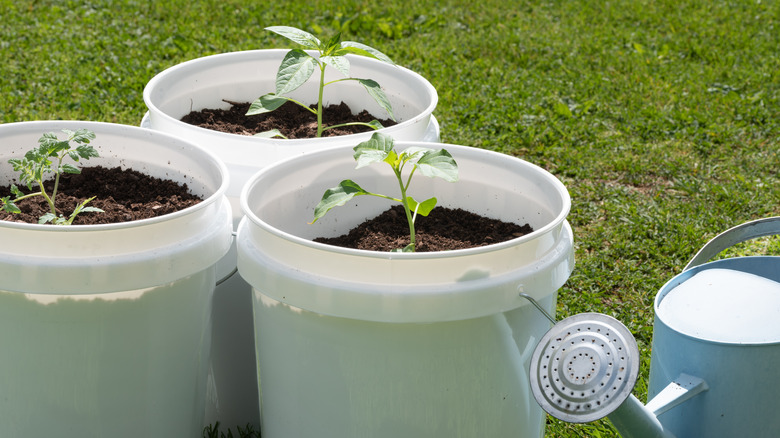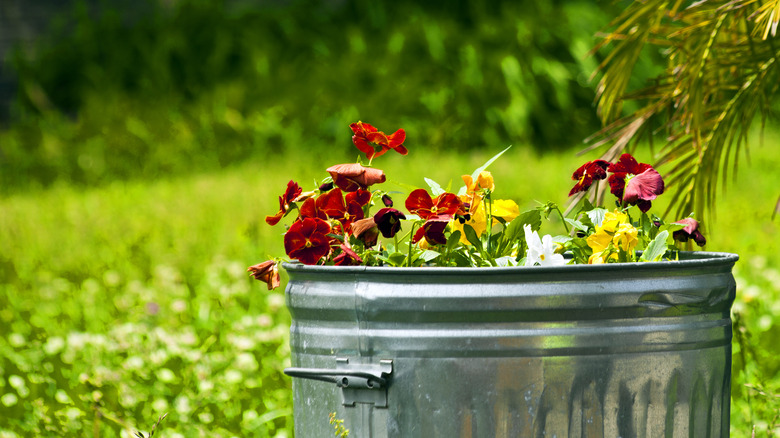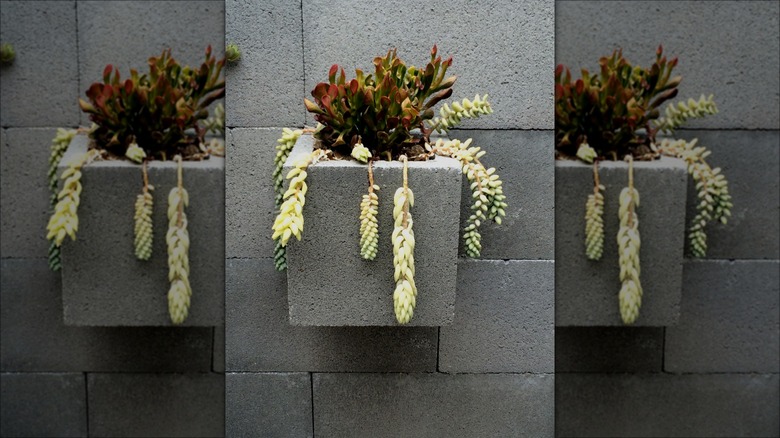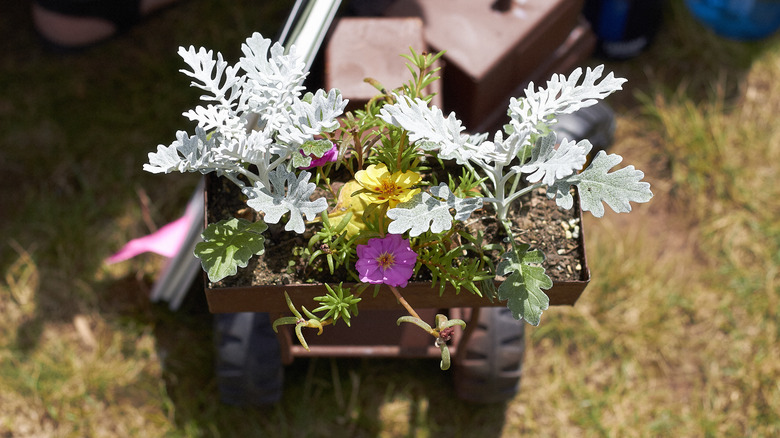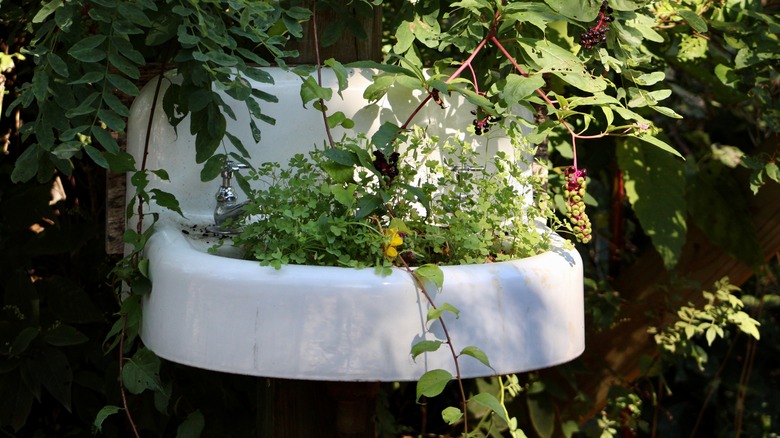Common Household Items You Can Turn Into Beautiful Planters
According to a study published in the Journal of Physiological Anthropology, having and interacting with plants inside our homes could have a positive impact on both physiological and psychological stress levels. Add on the fact that engaging in DIY activities is good for your physical and mental health, and you'll find that transforming everyday household objects you aren't using into your own custom planters is a two-part strategy to help you combat stress, clear out clutter, and spruce up your space.
If you're a bit intimidated by the idea of stepping into the DIY world, there's no reason to worry. At their core, planters are simply containers to hold soil, so most of these ideas only require you to give your object a good clean, fill it with dirt, and, if you're willing to make the effort, add a hole on the bottom or simply lay down a layer of rocks for drainage. Turning a household item into a planter is one of the simplest kinds of DIY projects out there, so it's a great place to start your upcycling journey or keep the ball rolling if you've already dipped your toe into the water. In many cases, these projects are also reversible, so if you find that your thumb isn't quite as green as you thought, you can easily return your object to its original purpose or use it as a base for your next idea.
Candle vessel
If you're guilty of hanging on to candles after they've already burned down to the bottom of the wick, you're not alone. Luckily, however, both that last little bit of wax and the candle vessel can be repurposed into something new. Place your candle in the freezer to pop out the last disc of wax, then break it up to use as a wax melt. Give the vessel a good rinse to clear out any soot or remaining wax, then fill it with dirt and a small plant. Place it wherever you see fit — your desk, the kitchen table, a nightstand — to bring in a pop of freshness.
Teapot
For a whimsical piece of décor that can easily be created using materials from your cabinet or the thrift store, consider making a teapot planter. Teapots with a larger opening at the top are going to be better suited for this purpose, so try to stay away from pieces that are more dome-shaped with a tiny lid. Fill the teapot with soil and your plant of choice, then water to ensure everything takes root. If you don't want to create drainage holes, the spout can also be conveniently used to rid your plant of excess liquid if you're worried that you've overwatered.
Bathtub
Turning a bathtub into a planter might be a bit of a bold statement for the average person, but it's a great way to repurpose an existing piece if you're planning to remodel. An old clawfoot tub will likely be your best bet for this DIY, but just about any standalone tub will work. All you need to do is fill the tub with soil and your plants — lucky for you, the drain is already built in. Keep it indoors as a conversation piece, or incorporate it into your backyard as a complement to an existing collection of eclectic outdoor décor.
Food tins
A lot of food packaging is meant to be flimsy and disposable to help cut down costs and reduce the amount of material used, but there's one kind of packaging that seems to do the opposite: tins. Whether they're used to hold tea, vegetables, cookies, or popcorn, metal tins and cans are usually much more sturdy — and well-decorated — than your average cardboard box or plastic bag. Because of this, they also make for great planters. Use a wide cookie tin to create a succulent garden, a few tea tins to grow herbs on your windowsill, or a popcorn tin to rehome a larger fern or small bush.
Boots
Boots, especially work and rain boots, can wear out and be grown out of quite quickly. If you have a pair of boots on hand that are past their prime or simply too small, consider turning them into a quirky planter. Rain boots are the primary contender for this kind of transformation, but just about any material that will hold water without deteriorating can be a good option. This includes anything made of faux leather, plastic, rubber, or real leather, so long as you're willing to work with a bit of sagging and creasing as they're exposed to the elements over time.
Serving bowls
You might be used to mixing up a salad or setting out a side of roasted vegetables in your serving bowls, but they can be useful for growing plants as well as just eating them. Serving bowls that aren't getting a lot of love in the kitchen are some of the easiest things to transform into a planter. Use deeper salad bowls as a home for plants that have a deeper, more involved root system, and use shallower dishes and bowls as a place for plants that don't need a ton of root space, like succulents.
Glass jars
Glass jars have earned quite the status in the upcycling community, and for good reason. These small receptacles originally intended to hold things like pasta sauce, jam, and pickles can be easily washed out and transformed into drinking glasses, vases, and, yes, planters. Remove the label on your jar and use some WD-40 to clear off any sticky residue, then fill it with a layer of pebbles for drainage and a large scoop of potting soil. Once you add in your plant, you'll be able to keep an eye on its water level and watch the development of the root system thanks to the transparent glass.
Paint can
If you've recently done a home improvement project or are looking to clear out some rotten paint in storage, consider turning the can into a planter. By far the most difficult part of this DIY is cleaning out the existing paint, but, in many cases, you can leave it out to dry and peel off the paint rather than having to scrub the inside of the can. After you repot your plant, you can use the handle on the paint can to suspend your plant from a hook or leave it on the ground or a plant stand for a more traditional look.
Coffee mug
If you enjoy a morning cup of hot tea or coffee, it's likely that you have a small collection of mugs received as gifts, purchased as souvenirs, and picked up as impulse purchases thanks to their cute design. It's also likely that you only routinely use a handful of these mugs, and the rest tend to sit in the back of the cabinet collecting dust. If this is the case, consider repurposing your old coffee mugs as planters. They're already built to hold liquid without leaking and they're the perfect size to hold a small plant in your kitchen or at your desk.
Tires
Replacing the tires on your car is a necessary — and often expensive — evil, but, to add insult to injury, many places require you to pay an additional tire disposal fee. To avoid this, consider turning your old tires into planters. You can orient your tire vertically to create a hanging planter or lay it flat on the ground and line it with a tarp to create something that sits lower on the ground. Because tires are made of thick rubber, they can get quite heavy, so it's best to place your planter in its intended final location before you start filling it with dirt.
Basket
Baskets might be more commonly associated with harvesting plants than growing them, but with the proper preparation, they can be transformed into an adorable planter. Because the weave on baskets isn't typically tight enough to be waterproof, you do need to add in a liner. A sheet of plastic, whether it's from a shopping bag, trash bag, or old tarp, should do the trick. Once you have your basket lined, cut a few holes in the plastic to allow for drainage. After this, all that's left to do is fill your basket with potting soil and plant your greenery of choice.
Wheelbarrow
If you've ever found yourself gazing wistfully at your wheelbarrow full of flowers as you use it for transport across the garden, wishing you could just keep your collection of perennials right where they are instead of planting them into the ground, this DIY is for you. Instead of simply using it to unload and move potting soil, flowers, and gardening tools, consider transforming your past-its-prime wheelbarrow into a planter. Fill it up with soil and vibrant flowers to create an on-theme centerpiece for your garden, complete with the ability to easily move it from place to place if you're craving a change in décor.
Plastic bottles
If you don't have any heavy-duty tools on hand but still want to get creative with your upcycling, consider making a planter out of a plastic bottle. Plastic is fairly flimsy and easy to cut through, meaning you can accomplish most ideas with just a pair of scissors or a craft knife. It also doesn't deteriorate quickly when exposed to water and the elements, so it's sure to last, even if sitting outdoors. Cut a hole out of the top of a large bottle to make a longer horizontal planter, or cut a smaller bottle in half and use the bottom portion as a simple flowerpot.
Colander
Colanders are the perfect kitchen tool to help you wash vegetables or strain your pasta, but a past-its-prime colander can have a secondary life in the garden, too. Because they're designed to allow water to drain without letting solids flow through, colanders will hold on to your plant's soil while letting the water trickle out, perfect for plants that are drought-tolerant and more prone to overwatering. Additionally, colanders usually have a set of handles on either side of the bowl to protect the user from burns, but these handles can also be used to add some chain or rope to make a hanging planter.
Dresser
A dresser might not be the first thing that comes to mind when you imagine a planter, but an old piece of furniture can make for a great display piece with a bit of TLC. If your dresser is made of a porous material, line the drawers with plastic, then get to work adding in your soil and plants. It is, however, important to consider that open drawers filled with heavy soil may cause your dresser to topple over. To fix this, secure the back of the dresser to the wall or add a counterweight on the back to balance everything out.
Bird bath
Bird baths are incredibly beneficial to the avian population if you're living in an area that's prone to drought and dry weather, but in some cases, they just don't get used as much as you'd like. If you find yourself in this situation, consider turning your bird bath into a planter. Bird baths are already designed to hold water so they're a prime candidate to hold soil. They will, however, likely be very difficult to drill any drainage holes into, so make sure you stick with plants that can handle an excess of water, especially if you live somewhere where it rains frequently.
Pitcher
Pitchers are frequently used as vases thanks to their similar size and shape, but if you're looking for a piece of décor a bit more permanent than cut stems that only last a week or two, consider turning your pitcher into a planter. If you have a pitcher with a fairly open mouth, it should be simple to transform it into a vessel for your next houseplant. Use your pitcher planter as a summery centerpiece on your dining table, or incorporate it into your bar cart décor as a thematically appropriate way to add a splash of color.
Purses
Cleaning out your closet is one of the best ways to improve your home's organization and reduce the amount of clutter you have floating around, but what do you do with the pieces you don't want to sell or donate? If you find yourself with a purse that you don't reach for often or that's a bit too damaged to donate, consider turning it into a planter. Pieces made of faux leather or plastic are ready to plant directly into, but if you're working with something made of less water-resistant fabric, consider adding in a plastic liner before filling it up with soil.
Tree stump
Unfortunately, sometimes, trees in our yards need to be cut down. Whether it's because they're simply in the way of our next building project, they've taken on damage from severe weather, or they've died as the result of a fungus or disease, they're never easy to let go of — and even harder to fully remove. Cutting down the tree itself is simple, but then you're left with a stump connected to a deep and expansive root system. To make something positive out of the situation, consider turning this leftover stump into a planter by carving out some of the wood in the center to make a bowl.
Fish bowls
Glass planters might be more commonly associated with terrariums, but they can also be used in more traditional settings. If you have an old fishbowl lying around, consider filling it with a layer of gravel, soil, and a plant for a sleek and modern planter that allows you to view the root system firsthand. Larger fish tanks can also be transformed into planters for larger-scale projects, and can even make for a living centerpiece in your home that takes significantly less effort than raising a school of fish.
Pots and pans
Cookware doesn't last forever, especially if you frequently find yourself in the kitchen. Instead of throwing it out once the paint starts to chip or the non-stick coating wears off, consider turning your old pots and pans into planters. Anything from an extra-large stockpot to a tiny saucepan can do the job, and the included handles can even allow you to hang or secure your new planter down so it doesn't slip around. If you're really looking to clean out your kitchen, the same thing can be done with old cake pans, casserole dishes, and even cupcake tins if you're looking to cultivate smaller plants.
Food storage containers
Food storage containers are great to have on hand if you frequently save your leftovers or meal prep for the week ahead, but, unfortunately, they can be a bit difficult to hold on to. Lids for these containers frequently end up lost or broken, effectively rendering your container useless unless you're willing to buy a replacement. If you find that you have bottoms of containers with no lids floating around, however, they can make for a great base for an upcycled planter. Poke a few holes in the bottom for drainage, then paint or decorate as desired if you're not a fan of the simple plastic look.
Buckets
Buckets are one of the easiest and simplest household items that you can turn into a planter. Thanks to their size, buckets are great to act as a base for a planter for larger plants you're cultivating. Plastic buckets, whether they're from a value-size container of ice cream or originally purchased for a home improvement project, can be painted or covered with rope to create a more polished-looking final product, then displayed either on the ground or used as a hanging planter with the proper mounting. If you're looking for something that doesn't require much sprucing up, however, metal buckets are already fairly decorative.
Trash cans
If you're looking to change out your existing trash can but don't want the old one to go to waste, consider turning it into a planter. Smaller trash cans used for the bathroom or under the desk are the perfect size for a medium-sized plant, and they come in a wide array of different colors, materials, and styles. Larger trash cans, however, can also be useful if you're looking to create a larger focal point in your garden. Fill it with dirt, then plant an array of different flowers and plants to bring a fresh second life to an old trash receptacle.
Cinder block
Cinder blocks are frequently used as building materials or as part of your home grilling setup, but they can also become a star inclusion in your garden. Thanks to their unique design, cinder blocks can hold two relatively small plants in each open section. If you want to keep this project small, you can simply add a bottom layer to your cinder block to keep the soil from falling out of the bottom, but the possibilities are endless. Build up cinder block walls to create a massive planter, or install them perpendicularly into a wall to create a floating planter sconce.
Kids' toys
If you have any old kids' toys lying around that your family has grown out of or lost interest in, consider turning them into quirky planters. Toy trucks and construction equipment are prime candidates for this treatment as they usually already have a built-in bed, but old wagons, plastic figurines, and toy trains make a great base as well. If you're willing to get a bit more crafty — and a bit more macabre — large doll heads can also be cut open, filled with plants, and given a coat of stone-textured spray paint to mimic the look of a bust.
Sink
By now, you likely realize that just about anything — including the kitchen sink — can be turned into a planter with the proper preparation. Thankfully, sinks, just like bathtubs, have drainage built in, so you don't have to worry about your plants becoming waterlogged even if your planter stays outside and you run into some wet weather. For this project, a standalone pedestal sink will likely be the easiest kind to work with, but just about any style from a stainless steel kitchen sink to a vintage porcelain bathroom sink will do the job if you're willing to haul it into your yard.
